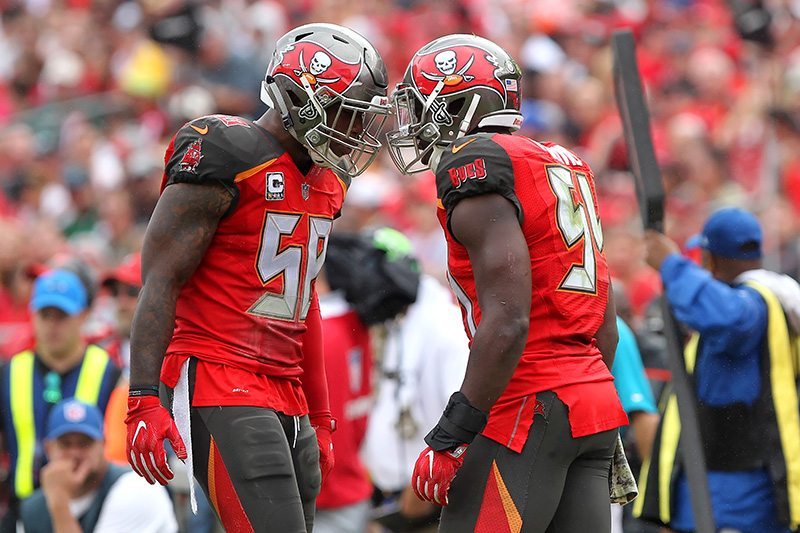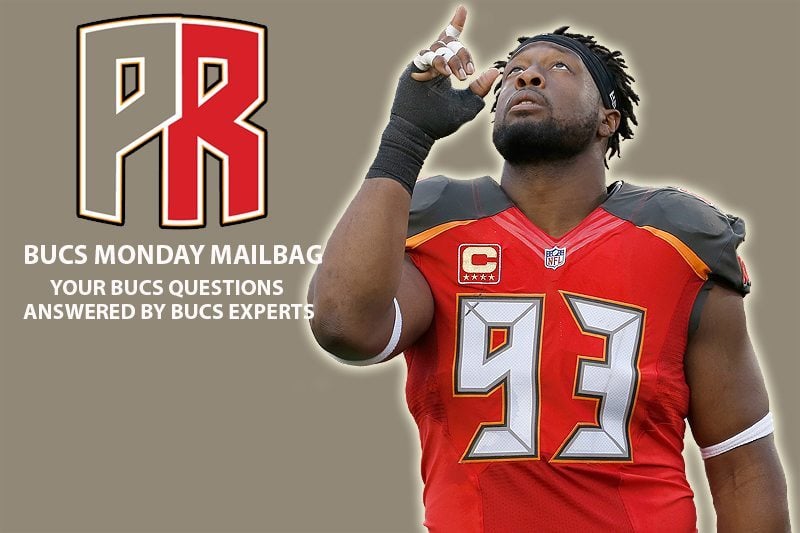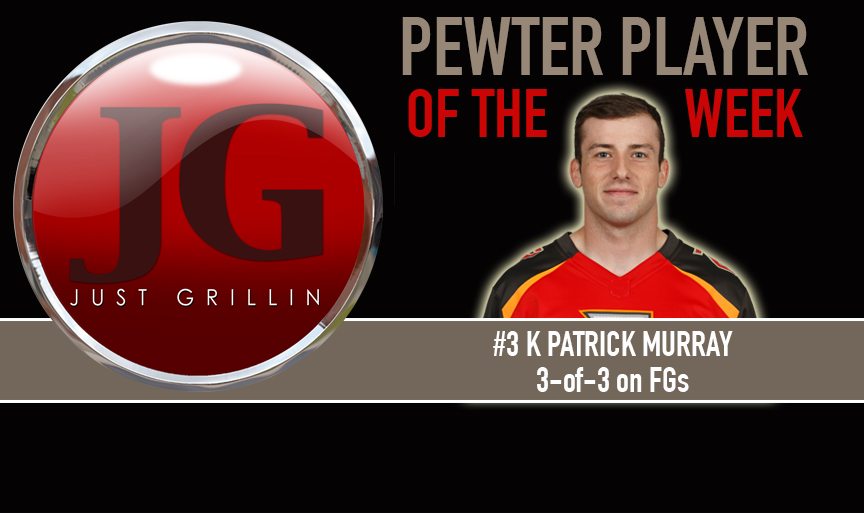All Twenty-Tuesday: A Defense Evolved
A big part of why the Bucs had success on Sunday against the Jets is because they played a more aggressive style of defense, not just in execution from the players, but also in how they were aligned.
Earlier this season I wrote a Cover 3 column on the soft coverage the Buccaneers were playing, highlighted in the Vikings game, and how soft coverage with the corners while revolving players at the safety positions was hindering any kind of pass rush and was altogether crippling the defense.
Though the Bucs did a better job of giving up space against the Jets, it’s not like they gave it up entirely – and you shouldn’t, soft coverage has to exists to keep the ball in front of you as a defense.
The play above is in 3rd-and-long, the Bucs played back, as you would expect, but no added pressure and slow anticipation led to a pass between the zone that, had it been thrown better, would have gone for the first down.
Again, in the play above we had some of the same defense that got the Bucs in trouble early in the season. In it, we saw soft coverage with just four pass rushers and a terrible stunt by the front four, which featured linebacker Kendell Beckwith as a pass rusher. That’s an elongated pass rush concept with coverage that gives space right off the bat. Understand why that wouldn’t work?
Thankfully, the Bucs seemed to only play that kind of coverage on third-and-long, which you can live with. I think they need to still play it better with spacing in the secondary, such as what space the safeties occupy, and with how they attack the pocket, but situationally, I can live with this.
The problem before was that Tampa Bay’s defense would be running this kind of coverage on first-and-10 or second-and-8, and would yield too many conversions before third down or too many third-and-shorts (which they also didn’t handle well before this past week).
That third-and-short situation is where I really saw the big changes, not only in efficiency, but in what was being called formation-wise with the Bucs defense against the Jets.
The play above isn’t a complete shift of coverage in terms of pre-snap alignment, but it was the next step towards them getting aggressive.
One of the first things I’m sure you noticed was the fact that the outside cornerbacks were still in somewhat off coverage. However, on the bottom of the screen, that was speedy wide receiver Robby Anderson on Brent Grimes, so that was just being tactically smart to give him space. What you should pay more attention to with the defensive backs is that safety Justin Evans was all alone in the deep zone in what can be determined after the snap as Cover 1.
This summer I went over every type of coverage shell in-depth, so if you want a refresher on that, you can find that here. But, in a sparknotes version, Cover 1 is a primarily a man coverage scheme that leaves one safety (hence the No. 1) in a deep zone and the rest of the players, linebackers and cornerbacks, in man coverage.
The reason you play this kind of coverage is for the exact reason that the play above was effective. By playing man coverage, you force receivers to create space on their own; this takes time. What is often combined with man coverage is extra pressure via blitzes. So, in theory, more pressure on a blitz means less time to throw as the pocket should collapse sooner, and the close coverage means a quarterback would have to wait longer for a receiver to get open. That’s why if you can blitz and play man coverage well it’s often a perfect marriage, especially on third down.
The play above is a perfect example of that marriage between pressure and close coverage working on a third down.
First notice once again that Evans was playing deep as a single-high coverage player. He has the speed to get from sideline-to-sideline and that’s something no other safety on this team has. That’s why it’s good he’s playing full time.
Next notice that all of the cornerbacks are playing press coverage due to the fact that it’s third down and just three yards to go.
Take that and compare it to what we saw in the Minnesota game.
Two-deep safeties with big time cushion from the cornerbacks, which yielded far too many conversions, even before the team got to third down.
That’s night and day different from what we saw on Sunday.
The advantages of playing closer coverage and more aggressive with the linebackers doesn’t just apply to the passing game. It can also help the team key in on runs in short yardage situations.
In the play above, the Jets needed just two yards to gain for the first down. Due to the nature of the coverage, when the ball was handed off, the linebackers were already en route to the A gap and stopped the play before it even got to the line of scrimmage.
Take note of the pressure up the middle in this play and in the play before it that we mentioned. When you play man coverage (and play it well, I should add) you don’t need two or even three defenders to occupy zones that a receiver might run to; you just need one player. Knowing that, it frees up others. That is usually substituted for extra pressure on the pocket. The Bucs did a much better job with tighter spacing for their defensive linemen on Sunday, and because of that, along with not needing them in coverage due to man assignments, they were able to get blitzing players free.
When you play a more attacking style of defense, you give yourself a chance against better teams. Look at the last few Super Bowl teams. The Broncos, the Seahawks, the Patriots; they all play an aggressive style, and most of them played from multiple, 3-4 sets like we saw the Bucs play from on Sunday against the Jets.
For the first time this year I watched a Buccaneers defense that wasn’t playing timid and had an identity.
Training Another Lavonte David
The Bucs are doing some fun things were their three linebackers, and when I say fun, I use that word only because it’s becoming effective – when it’s not, it’s miserable, of course.
Due to a combination of injuries, bad execution and unexpected talent, the Buccaneers have recently tried to do whatever they could to keep their three linebackers, David, Alexander and Beckwith, on the field at the same time. This has resulted in some unorthodox-looking formations.
The staples of defensive football come from 4-3 or 3-4 formations. There are two other formations called nickel and 46, which are sub packages of those formations, but for the most part, it’s one of those four.
The 3-3-5 formation is a variation of the nickel formation you would use as a 3-4 team. In it, you still have five defensive backs on the field, but instead of the traditional nickel formation where you have four down linemen and just two linebackers, you have three down linemen and three linebackers. This ideology comes from the 3-4 base formation, and is usually preferred because the third linebacker being prioritized is often a stand-up linebacker, not one who like to put his hand in the ground, when rushing the passer.
I used the play above as an example for a few reasons. For one, it was on the first series of the game, which showed confidence in the team going to a 3-3-5 early. Next, I wanted to point out the creative spacing of the defensive linemen. This wasn’t just a vanilla 3-3-5 where the defensive linemen were evenly placed (as we saw in Buffalo, which failed). It was obscure and created chaos on the offensive line. Finally, I wanted to note which linebackers were where. In this particular play, Alexander was the middle linebacker while Beckwith and David were on the edges.
I could highlight a number of different aspects of the Bucs’ 3-3-5 on Sunday, such as the defensive line alignment or Alexander’s effectiveness blitzing up the middle in the A gap, but what I really want to focus on is the play of Beckwith and how they’re truly using him as a multi-dimential linebacker.
In the play above, Beckwith was once again on the edge. One thing that caught my eye in the Buffalo game that was a positive from this formation was that Beckwith was pretty good at rushing from the edge. If you’ve followed my Cover 3 column since the draft, you know that I wasn’t the biggest fan of the Beckwith pick to begin with. I was skeptical about him playing the SAM (strongside) linebacker position, and I wondered if he could be explosive and strong enough off that ACL injury. So far, not only has he proven to me he could come back from that injury, but he’s also surpassed the player he was at LSU. He’s definitely proven me wrong in that sense.
Beckwith has proven that he can be an effective stand-up edge player, something I didn’t see coming. Remember, this guy was leading the Bucs in tackles as a rookie for most of this year. He currently has 50 tackles to lead all rookies, which is one behind David’s 51 for the team lead.
What was most impressive about Beckwith in the game against the Jets wasn’t just how well he was able to play as an edge rusher where he was able to get his first NFL sack, but also how well he played all three linebacker spots.
In the play above, the Bucs were once again in the 3-3-5 formation, but this time Beckwith was the middle linebacker. Beckwith is showing he has the natural ability to play all three linebacker spots. For years the Buccaneers have been using David to do things like that. The Bucs have used David as a weakside linebacker to play in space, a middle linebacker who took the defensive calls, a key contributor in zone and man coverage and as a player who could be effective off the blitz.
Eight games in, especially the one last week, and it’s clear that they’re shaping Beckwith to be another David-type player, capable of being used all over the field.
I highlighted this play earlier in the piece to focus on the type of coverage that was being deployed, but I want to take a look at it again with the focus being on Beckwith.
Beckwith was the edge linebacker on the bottom of the screen by the right tackle. He did a good job of not giving away whether he was blitzing or dropping to a man coverage assignment, and because of that, the quarterback was left guessing. As the ball was snapped, Beckwith followed his man out of the backfield to the sideline and eventually closed well enough to knock the ball away or knock the running back when he was catching it.
This is a responsibility you don’t see the Bucs really give to anyone other than David. Alexander drops into man coverage at times, and I don’t mean this to be a knock on him, but covering a running back in the flat or a slot receiver on the inside are things David used to do. With Beckwith now doing those things, it frees up David to do other things of similar versatility on the opposite side. I can’t remember the Bucs trusting any linebacker to play the roles David has in the way they’re letting Beckwith do so.
As if Beckwith taking some of what would normally be David’s responsibilities on sub package roles isn’t enough to convince you, check out the clip above.
David is one of the best weakside linebackers in the NFL. He’s made Pro Bowl and All Pro honors from this spot. He plays other roles on the defense, but they all come from that weakside linebacker spot. However, in the play above, David is playing as the SAM linebacker on the side of the tight end. This is likely because David is experienced with taking on blocks, blitzing if needed and also in covering the tight end. But, even though that is the case, they wouldn’t move him from that weak side linebacker spot unless they had someone they were confident could play it in his place.
Who replaced David as the weakside linebacker here? Yep, you guess it, Beckwith. And thus completed the David rotation of roles that Beckwith was asked to play on Sunday, something I never though I’d see from him in Year One.
Beckwith isn’t as fast or athletic as David is, so in that sense he might not hit that David-high ceiling. However, this team has a ton of confidence in Beckwith, so much so that they want him to be a David clone in some of the ways it can use him. Having two linebackers like that who can mix it up on the edge, in the middle, in base package and sub package all allow the Buccaneers to be counter artists when matching up against opposing offenses.
Click to the next page to discuss what we just saw and learned, and how you might like to see it be continued or modified moving forward.




